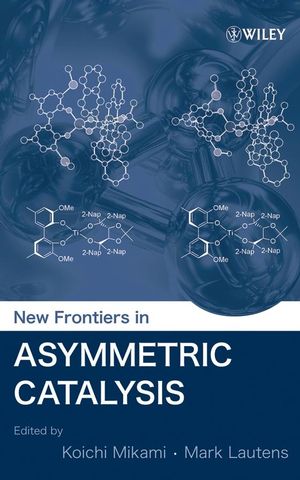New Frontiers in Asymmetric CatalysisISBN: 978-0-471-68026-0
Hardcover
448 pages
May 2007
 This is a Print-on-Demand title. It will be printed specifically to fill your order. Please allow an additional 15-20 days delivery time. The book is not returnable.
|
||||||
A compilation of recent advances and applications in asymmetric
catalysis
The field of asymmetric catalysis has grown rapidly and plays a key role in drug discovery and pharmaceuticals. New Frontiers in Asymmetric Catalysis gives readers a fundamental understanding of the concepts and applications of asymmetric catalysis reactions and discusses the latest developments and findings. With contributions from preeminent scientists in their respective fields, it covers:
* "Rational" ligand design, which is critically dependent on the reaction type (reduction, oxidation, and C-C bond formation)
* Recent findings on activation of C-H bonds, C-C bonds, and small molecules (C=O, HCN, RN=C, and CO2) and the latest developments on C-C bond reorganization, such as metathesis
* Advances in "chirally economical" non-linear phenomena, racemic catalysis, and autocatalysis
* Some of the recent discoveries that have led to a renaissance in the field of organocatalysis, including the development of chiral Brönstead acids and Lewis acidic metals bearing the conjugate base of the Brönstead acids as the ligands and the chiral bi-functional acid/base catalysts
The book ends with a thought-provoking perspective on the future of asymmetric catalysis that addresses both the challenges and the unlimited potential in this burgeoning field. This is an authoritative, up-to-date reference for organic chemists in academia, government, and industries, including pharmaceuticals, biotech, fine chemicals, polymers, and agriculture. It is also an excellent textbook for graduate students studying advanced organic chemistry or chemical synthesis.
The field of asymmetric catalysis has grown rapidly and plays a key role in drug discovery and pharmaceuticals. New Frontiers in Asymmetric Catalysis gives readers a fundamental understanding of the concepts and applications of asymmetric catalysis reactions and discusses the latest developments and findings. With contributions from preeminent scientists in their respective fields, it covers:
* "Rational" ligand design, which is critically dependent on the reaction type (reduction, oxidation, and C-C bond formation)
* Recent findings on activation of C-H bonds, C-C bonds, and small molecules (C=O, HCN, RN=C, and CO2) and the latest developments on C-C bond reorganization, such as metathesis
* Advances in "chirally economical" non-linear phenomena, racemic catalysis, and autocatalysis
* Some of the recent discoveries that have led to a renaissance in the field of organocatalysis, including the development of chiral Brönstead acids and Lewis acidic metals bearing the conjugate base of the Brönstead acids as the ligands and the chiral bi-functional acid/base catalysts
The book ends with a thought-provoking perspective on the future of asymmetric catalysis that addresses both the challenges and the unlimited potential in this burgeoning field. This is an authoritative, up-to-date reference for organic chemists in academia, government, and industries, including pharmaceuticals, biotech, fine chemicals, polymers, and agriculture. It is also an excellent textbook for graduate students studying advanced organic chemistry or chemical synthesis.



